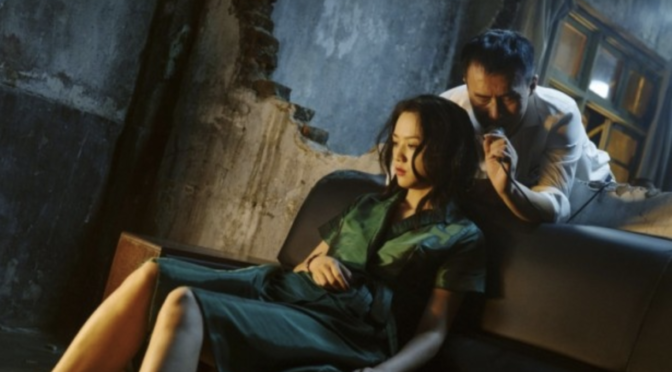LONG DAY’S JOURNEY INTO NIGHT is directed by Bi Gan, the 30-year old Chinese filmmaker who’s already become something of an arthouse superstar thanks to KAILI BLUES, his formally and technically audacious debut. These two films clearly announce the formation of a young director possessing enormous imaginative resources and a skill for finding and making expressive images and sounds — even if this second feature is a notable step down in qualitative terms.
The film’s subject is Luo (Huang Jue), a man who has returned to his childhood home for the funeral of his father. He’s distracted by the memories activated by the spaces and sounds he once knew; he remembers a lost love, Wan Qiwen (Tang Wei, of LUST, CAUTION fame), a femme fatale in a VERTIGO-green dress. Luo’s also haunted by the memory of a dead friend, named Wildcat, who died after falling on the wrong side of an elusive gangster (who happens to be Wan’s partner).
The first section is a scattering of film noir and Wong Kar-wai, with accents of Andrei Tarkovsky’s slow-moving camerawork and a touch of Tsai Ming-liang’s obsession with water and time. This is one way of saying it’s a mess. Bi appropriates, entirely at surface-level, Wong’s preoccupation with weaving in and out of past and present; while the noirish elements collapse because of an absolute lack of atmosphere and eroticism. There’s also a scene which lifts its mise-en-scḕne directly from a shot in Carl Thedor Dreyer’s ORDET, and it has no reason to. It’s difficult to connect these disparate referents to each other: the result is a film which bides its time rather than sculpts with it.
LONG DAY’S JOURNEY has — as KAILI BLUES does with greater force and portent thanks to the poems, read on the soundtrack, which reinvigorate the film’s idea of meaning-making, resounding through the film like shouts down echoing corridors — a kind of cinematic rhyming scheme. Something mentioned, halfheartedly or quietly, which will reappear with new emphasis and in a new context each time it resurfaces. Perfect for noir, you would think, a sort of filmmaking renowned for mystery and convolution. Unfortunately, not so.
Bi’s film is an academic exercise, a vague attempt to construct a thesis on how the workings of memories, dreams, and cinema can confuse someone’s experience of the present. The director’s style, utterly detachable from the movie of which it is supposed to be a constituent part, is a reflection of the vagueness of the film’s ideas. Up until the moment Luo sits in a dank and decrepit cinema and dons a pair of 3D glasses, LONG DAY’S JOURNEY INTO NIGHT seems like a total bust.
Then the screen goes dark and, eighty minutes into the picture, the title card drops. The rest of the film plays out in one fifty-minute travelling shot, and boy does it travel: into a mine shaft, on a motorbike, down a zip wire, on foot for lengthy periods, and — thanks to this section of the film’s predilection for acts of the supernatural variety — through the air. Yes, after a ping-pong paddle is spun around in the moonlight, Luo and a new character he meets named Kaizhen (a double of Wan) ascend. The camera’s airborne movement is achieved with the aid of a drone: harking back to KAILI BLUES’s own forty-minute drone shot near its conclusion — which may be shorter in duration than this long-take, but is doubly evocative.)
Despite the film’s many disappointments, this concluding shot contains a fascinating tension: Luo’s digressive journey, which piles diversion upon interruption upon frustration upon coincidence upon accident, is at odds with the fluidity of how the shot is captured. The uncanniness and the oneiric qualities of the sequence are multiplied by its unbroken form.
While this doesn’t compensate for the film’s absence of feeling, it provides a point of interest, and while it doesn’t excuse a set of generally indifferent, uninhabited performances (perhaps the fault of an uninhabitable script), it offers a chance for one of Bi’s three directors of photography (Yao Hung-i, Dong Jingsong, and David Chizallet) some chance to demonstrate their skills. (Oh, and speaking of performances, Sylvia Chang, whose presence is the film’s greatest pleasure, appears in two roles; one of which witnesses her, with red hair, wield a burning torch in a rage: Chang is formidable, and she enlivens the screen while she’s on it.)
The work Bi completes after the film will, without doubt, be one of the major cinema stories of the 2020s — and though this movie may enervate and even exasperate, it’s still far preferable to watch a filmmaker throw ideas into work which fail to ignite than watch umpteen films with no ideas at all.

